Thursday, August 31, 2006
Corrections and Ephemera
Some corrections, amplifications, and other bits of information that have been pointed out along the way:
Thanks again for visiting my museum in late July. I understand that the visit DID make an impression on you!
I know so because you dedicated a few paragraphs and three pictures about me and my museum on your blog!
IF you are interested in learning more about the truth. You now have my email...
Best Wishes,
- The reservoir I crossed on the way into Ohio was the Pymatuning Reservoir, which flows out of and back into the Shenango River (referred to, obliquely, in a subsequent post).
- I wavered between "hub" and "epicenter" of the Chicago area in trying to remember how Elmhurst, Illinois, was described. Turns out it was "epicenter." The Wiener's Circle is restored to its former status as the hub. I've corrected the post for future generations of readers.
- I looked at the post "Big Shoulders" and discovered I'd used the word "profound" or "profoundly" four times in one paragraph. Apparently I thought I had something profound to say. Maybe I should get an editor, or at least read the damn thing before I hit the "publish" button. I will try to keep in mind henceforth my professor John Ward's advice, at another time when I guess I needed it, that adjectives tend to be an extra and unwanted strum of the guitar.
- The Quad Cities Swing, I have realized, are formally named "The Swing of the Quad Cities." That's what the announcer kept saying. Sort of like "The College of Wooster," only even more annoying. Not as annoying as "The Ohio State University," however. It turns out there is a swing connection, too. Bix Beiderbecke, whom you've probably never heard of but maybe ought to, was a notable cornet player and bandleader born in Davenport. According to Wikipedia, Louis Armstrong never played the tune "Singin' the Blues" because he thought Beiderbecke's classic recording of the song shouldn't be touched. "Lots of cats tried to play like Bix," said Satchmo; "ain't none of them play like him yet."
Dear Chris:
Thanks again for visiting my museum in late July. I understand that the visit DID make an impression on you!
I know so because you dedicated a few paragraphs and three pictures about me and my museum on your blog!
By reading your account of our encounter, I have the impression that you wish you didn't have it. I also understand that you never did find out why John Hanson is our first president!
But in your account on the blog, you stated exactly what I was trying to get across to you... one, that people are not willing to go out of their way to find the truth (hence, you kept complaining about not being kept to your schedule-- like your schedule is more important than the truth!)
two, that people are more afraid of what their friends and peers think about them and their actions are predicated on this weak supposition. Until people are willing to stand up for the truth! and there is only one truth! this country, this world is going to continue to be the way it is!
My quest for the country, the world to know that John Hanson is the first president is only the tip of the iceberg.
The more important thing is to understand that we as a nation, a world can easily be deceived if we put our own selfish interests first. We are put here for a reason, mainly to witness to the truth!
So as a teacher, you can either stand up and take a stand for your students or you can continue to usher them down the ``path of least resistence'' (i.e. the easy way) and send them to the ignorance and oblivion that many seem to be too satisfied with today.
IF you are interested in learning more about the truth. You now have my email...
please be safe on your journeys.
Best Wishes,
Nick Pahys Jr.
One and Only Presidential Museum
For different reasons, it may be a few days before the next post. So in the meantime here's some stuff I've wanted to send along but that just hasn't fit anywhere else.
Mennonite girls on the Tumble Bug at Conneaut Lake Park:

A bumper sticker in Louisville. Does this mean that when a man and a woman meet, they must marry each other and have two children? It's a bit elliptical. FYI, the Unitarians in Louisville had a big banner on their church reading "Civil marriage is a civil right."

I'm a little curious about the Triple X Family Restaurant in West Lafayette:
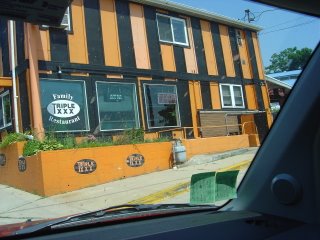
The sort of thing you find wandering around the U Chicago campus:

and driving around Chicago:
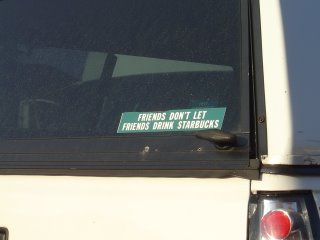
A couple details from the amazing Rookery Building in Chicago:
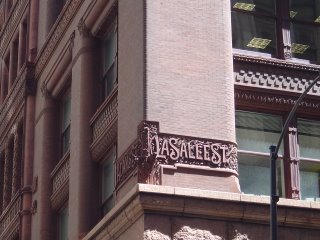

And the equally amazing exterior of the Carson Pirie Scott store in the loop. The interior was gutted long ago, unfortunately. At least it isn't suffering the indignity of being renamed Macy's like its neighbor Marshall Fields. Yet, anyway.
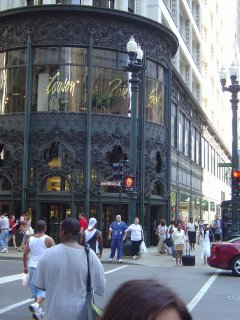
And the Carnegie Library in Sterling, Illinois:

It could be almost anywhere, really, but this is a fine example and apparently still in use as the public library. The vast majority of Mr. Carnegie's libraries, although their details differ, follow the same basic layout: children's reading room on one side; adult reading room on the other side; librarian as magistrate in the center, with stacks behind. There was some substantial theory behind it, promulgated by the Carnegie folks - you can read a good summary of the arrangement here. I'm a graduate of just such a library in Delaware, Ohio - no longer in use as the library unfortunately, but still standing and recently restored and expanded - and every time I walk into one of its cousins I feel like I'm back home.
For different reasons, it may be a few days before the next post. So in the meantime here's some stuff I've wanted to send along but that just hasn't fit anywhere else.
Mennonite girls on the Tumble Bug at Conneaut Lake Park:

A bumper sticker in Louisville. Does this mean that when a man and a woman meet, they must marry each other and have two children? It's a bit elliptical. FYI, the Unitarians in Louisville had a big banner on their church reading "Civil marriage is a civil right."

I'm a little curious about the Triple X Family Restaurant in West Lafayette:

The sort of thing you find wandering around the U Chicago campus:

and driving around Chicago:

A couple details from the amazing Rookery Building in Chicago:


And the equally amazing exterior of the Carson Pirie Scott store in the loop. The interior was gutted long ago, unfortunately. At least it isn't suffering the indignity of being renamed Macy's like its neighbor Marshall Fields. Yet, anyway.

And the Carnegie Library in Sterling, Illinois:

It could be almost anywhere, really, but this is a fine example and apparently still in use as the public library. The vast majority of Mr. Carnegie's libraries, although their details differ, follow the same basic layout: children's reading room on one side; adult reading room on the other side; librarian as magistrate in the center, with stacks behind. There was some substantial theory behind it, promulgated by the Carnegie folks - you can read a good summary of the arrangement here. I'm a graduate of just such a library in Delaware, Ohio - no longer in use as the library unfortunately, but still standing and recently restored and expanded - and every time I walk into one of its cousins I feel like I'm back home.
Monday, August 28, 2006
Northern Iowa, Southern Minnesota
 I head up back roads through towns named New Vienna and Luxemburg and meet the Mississippi again at Guttenberg, Iowa, where the road plunges over a cliff back down to the flood plain. After dinner it gets dark, and I either miss a sign for the Great River Road or it isn’t there, and I find myself wandering around under an Iowa moon, past a county fair that’s letting out and down one gravel road after another, each twistier and more rutted than the last.
I head up back roads through towns named New Vienna and Luxemburg and meet the Mississippi again at Guttenberg, Iowa, where the road plunges over a cliff back down to the flood plain. After dinner it gets dark, and I either miss a sign for the Great River Road or it isn’t there, and I find myself wandering around under an Iowa moon, past a county fair that’s letting out and down one gravel road after another, each twistier and more rutted than the last.Suddenly the sign in front of me announces US 52, and it’s a measure of how bad things had gotten that I’m absolutely convinced the sign has north and south backward. I choose to believe it, and it turns out to be right. I have no idea what happened. The map says I’m not following the route I wanted to, but I don’t really have much choice but to follow it at the moment.
Yes, it's a surprising and memorable, as well as valuable, experience, etc. But strictly speaking these are not the woods.
Up US 52, five miles outside of a town called Postville, Iowa, I pass a gigantic billboard for El Sabor Latino grocery. I arrive in the town at about 10:00 and there it is, the biggest grocery in town, right next to the pasteleria. Which I mention only by way of recording my surprise, regular and ongoing during this trip, at the way pockets of Mexican culture are located all over the midwest - even here in small-town Iowa, where there aren't the industries I would immediately think of as attracting immigrants. Or where, for that matter, my snobbish assumption would have been that the arms weren't be quite as open. It has, at the least, altered my perception, heretofore shaped largely by living in New York for 10 years and reading the daily digest of the Cadillac liberal, of how immigration is really happening.
Everything in Postville is closed, unfortunately - in these parts if you ask somebody where you can get a meal at 8:20 in the evening they look at you doubtfully.
I turn round with my eyes shut near Decora. Somewhere in the night, the landscape has changed; in the morning, I discover I've left behind the river's reach, and find myself on the great plains.
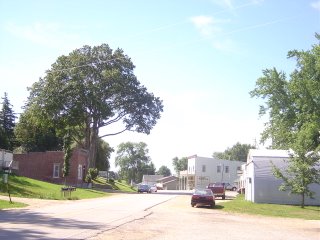 Driving north I come to Burr Oak, Iowa, which claims Laura Ingalls Wilder as a former resident. If you are planning the Laura Ingalls Wilder tour of the midwest, this is probably an essential stop. Otherwise, I have done this one for you. Here it is: at some point Pa was asked by friends to help them manage the hotel at Burr Oak. They lived there for approximately a year, which was documented in none of the books. The pleasant college kid running the (single) gift shop tells me they like to think that the Burr Oak year inspired the "Little House" television show, which in total desperation made the Ingalls family into innkeepers. He says this with "Yeah, right" written all over his face.
Driving north I come to Burr Oak, Iowa, which claims Laura Ingalls Wilder as a former resident. If you are planning the Laura Ingalls Wilder tour of the midwest, this is probably an essential stop. Otherwise, I have done this one for you. Here it is: at some point Pa was asked by friends to help them manage the hotel at Burr Oak. They lived there for approximately a year, which was documented in none of the books. The pleasant college kid running the (single) gift shop tells me they like to think that the Burr Oak year inspired the "Little House" television show, which in total desperation made the Ingalls family into innkeepers. He says this with "Yeah, right" written all over his face.The hotel still exists, and I take a lousy picture of it, but decide the tour might be a little much, and gift-shop guy does not disagree.
There's an interesting octagonal barn just north of Burr Oak:
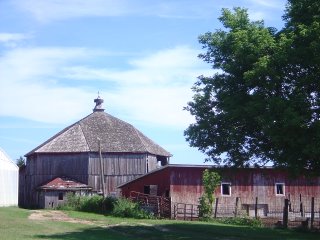
 and then a few miles north of that I cross into Minnesota. I swear to you, not two minutes after I pass this sign, I hear Garrison Keillor's voice on my radio introducing the Writer's Almanac for Monday, August 7.
and then a few miles north of that I cross into Minnesota. I swear to you, not two minutes after I pass this sign, I hear Garrison Keillor's voice on my radio introducing the Writer's Almanac for Monday, August 7.I stop for lunch and a bike ride in Preston, Minnesota, and then wind my way to Kenyon. I know of Kenyon only because of a student from here who once applied to Pomona College, which amused us. I stop long enough to ask about the town's name at the library, and it turns out that town was, in fact, founded by three Kenyon graduates more or less on spec, and they decided to honor dear alma mater. I really hadn't expected that to be the case.
While I'm waiting for librarian to make a couple copies, a man in the library strikes up a conversation with me. He's about 75 and nearly blind. Tells me if only his supervisor weren't around he'd be able to carry on a little more, talk to the pretty girls. His wife studiously ignores the both of us.
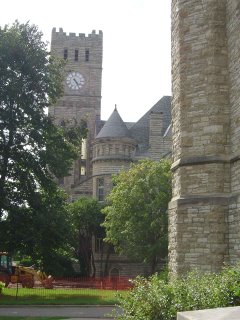 Faribault is down the road. If airlines still handed out blankets, this is where they would come from. When I was working at Pomona, I had a memorable stop here at a prep school called Shattuck-St. Mary's that sits up on a hill above the Cannon River. The campus is all torn up now, and it's mid-afternoon instead of late evening, and the engaging students and college counselor who gave me the tour back then are now nowhere to be seen. But I can still see why I thought the place was beautiful.
Faribault is down the road. If airlines still handed out blankets, this is where they would come from. When I was working at Pomona, I had a memorable stop here at a prep school called Shattuck-St. Mary's that sits up on a hill above the Cannon River. The campus is all torn up now, and it's mid-afternoon instead of late evening, and the engaging students and college counselor who gave me the tour back then are now nowhere to be seen. But I can still see why I thought the place was beautiful.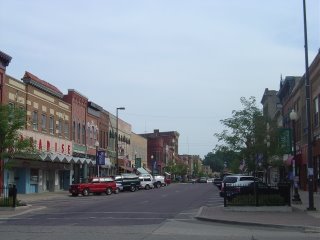 Faribault - pronounced "Faribo," by the way - looks like it's getting by, trying to figure out what to do with its downtown now that nobody shops there. The Paradise theater, on the left, is being converted into the Paradise Center for the Arts, according to a display in the window, and there's a coffeehouse and the like, but not really enough to fill two blocks worth at this point.
Faribault - pronounced "Faribo," by the way - looks like it's getting by, trying to figure out what to do with its downtown now that nobody shops there. The Paradise theater, on the left, is being converted into the Paradise Center for the Arts, according to a display in the window, and there's a coffeehouse and the like, but not really enough to fill two blocks worth at this point. At the end of the main drag is an unusual building that turns out to be the library. From the outside, I love it. Inside, it turns out to have been the victim of a well-meaning but unfortunate renovation that wholly stripped the building of any original details. The one exception is a stained glass window, right under the clock, by Charles J. Connick that makes the stop worthwhile. Nobody using the library seems to realize what they've got here.
At the end of the main drag is an unusual building that turns out to be the library. From the outside, I love it. Inside, it turns out to have been the victim of a well-meaning but unfortunate renovation that wholly stripped the building of any original details. The one exception is a stained glass window, right under the clock, by Charles J. Connick that makes the stop worthwhile. Nobody using the library seems to realize what they've got here. From Main Street in Faibault I finally get around to calling my cousin Joel, who lives in Minneapolis. I'd seen Joel in Michigan and he'd told me where to find the key, since he and the rest of my cousins were all headed to Yellowstone. Back then, we thought I'd have gotten to Minneapolis long ago, ha ha. It turns out they've all had time to get to Yellowstone, see bears and such, and return in the time it's taken me to get from Michigan to southern Minnesota. Anyway, they're home, and invite me to crash in their guest room on a few hours notice.
From Main Street in Faibault I finally get around to calling my cousin Joel, who lives in Minneapolis. I'd seen Joel in Michigan and he'd told me where to find the key, since he and the rest of my cousins were all headed to Yellowstone. Back then, we thought I'd have gotten to Minneapolis long ago, ha ha. It turns out they've all had time to get to Yellowstone, see bears and such, and return in the time it's taken me to get from Michigan to southern Minnesota. Anyway, they're home, and invite me to crash in their guest room on a few hours notice.This is kind of the way it goes. Those of you not on my route are lighting candles right now.
To give Joel and family a few more minutes to prepare, and also because this is kind of the way it goes, I stop in Northfield, a few miles up the road. Northfield is famous for being the place where the Jesse James Gang finally got its comeuppance (most of them, anyway - the James brothers themselves were able to flee to the Dakotas). I take a picture of the wrong building.
(You can see the real building here.)
 Northfield is also the home of Carleton College. Carleton was where I wanted to go to college when I was a senior in high school but I didn't have the tools at the time to explain to my parents why I wanted to turn down a scholarship to Kenyon in order to go to a school they'd never heard of in Minnesota. I don't know if I'd have those tools now; it was a lot of money. And I don't particularly regret it. It's just meant that Carleton has always been filed in the mental drawer where you might put the guy you never married, the job you didn't take.
Northfield is also the home of Carleton College. Carleton was where I wanted to go to college when I was a senior in high school but I didn't have the tools at the time to explain to my parents why I wanted to turn down a scholarship to Kenyon in order to go to a school they'd never heard of in Minnesota. I don't know if I'd have those tools now; it was a lot of money. And I don't particularly regret it. It's just meant that Carleton has always been filed in the mental drawer where you might put the guy you never married, the job you didn't take.The campus is just as I remember it; mostly unpretentious and totally mismatched - practically a history of American academic architecture arranged around a single quad.
Night's falling, and I head up Route 3 to Minneapolis, and only get lost twice.
Sunday, August 27, 2006
Tall Corn
 I head west out of Galena. There’s an aquarium and museum of the Mississippi River at Dubuque, where I cross the river, but it’s unlikely to be open at 6:00 on a Sunday evening. Instead I drive west on US 20, into the heart of the corn belt. We grow a lot of corn in this country, and an exceptional amount of it seems to come from Iowa. In Indiana and Illinois, at least, I would see fields of alfalfa or beans or occasionally something more exotic, but I drive literally miles in Iowa before I see anything but corn. In places the land looks six or seven feet higher than it actually is because all you can see are the tops of the plants.
I head west out of Galena. There’s an aquarium and museum of the Mississippi River at Dubuque, where I cross the river, but it’s unlikely to be open at 6:00 on a Sunday evening. Instead I drive west on US 20, into the heart of the corn belt. We grow a lot of corn in this country, and an exceptional amount of it seems to come from Iowa. In Indiana and Illinois, at least, I would see fields of alfalfa or beans or occasionally something more exotic, but I drive literally miles in Iowa before I see anything but corn. In places the land looks six or seven feet higher than it actually is because all you can see are the tops of the plants.I’ve composed two separate rants about this, involving any number of disparate factors and agents of evil, but I’ve twice decided not to bore you. Those of you who are interested can ask me about it.
But regardless of my opinions on the stuff, I drive west to see the most famous cornfield in Iowa, the one where they filmed the climactic scene of “Field of Dreams.” I feel like a complete dope for doing this, the whole way there. It’s due west of Dubuque on 20, and then up a state highway, and then across a county highway, and then up another little road, and then a left, and a right. There are little signs at all the critical points. I seem to be the only person stupid enough to do this, to go see a corny movie location in a corny state, and every time I pass a car I feel my New York plates glowing like a giant zit on the Element’s nose.
It turns out I’m only half wrong: it’s worth doing, but not for any reason that might have occurred to me. It turns out there are two Field of Dreams franchises, located side by side on adjacent farms that share the baseball field.

I pull into the first driveway, because - well, because I’m confused. This turns out to be the “Left and Center” Field of Dreams site. That is, they own left field and part of center field, and have a couple of pieces of dubious looking memorabilia, and a gift shop. Mostly, in fact, they have a gift shop, where I buy a grape soda and a bag of popcorn.
Then I cross the invisible boundary into the “Original” Field of Dreams site, and notice the sign informing me that the gift shop along the third base line is run by imposters who had nothing to do with the film. The “Original” FOD site is the one director Phil Alden Robinson was looking at when he shouted “That’s it! That’s my farm!” coming over the hill, the literature tells me. It’s only an accident of baseball geography that the other farm is involved at all. In fact, it’s run by out of state interests.
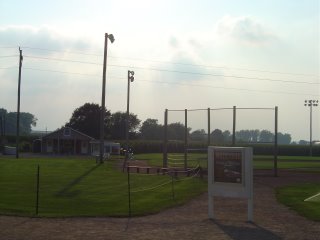
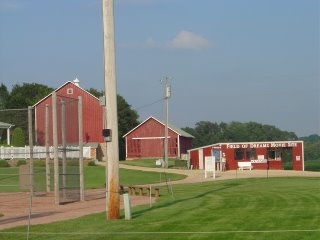
Now I feel guilty for having bought my popcorn over at the Left and Center FOD gift stand, so I go over and buy a couple of postcards from the Original FOD shop, and make sure to sign their guest book and not other one. Frankly, the L&C folks had better merch, but I can’t buy anything more from them, now can I?.
And then I start to muse on the authority for any of these claims, and beyond that the snottiness of the OFOD signage, and the suggestion that you could have an acceptable baseball diamond that didn’t include left and center fields, and decide to be equal parts amused and disheartened at the state of things in America that two farmers side-by-side in Iowa couldn’t manage to get along enough to share the proceeds from a single gift shop, and instead are operating duplicate concessions at an attraction where, at this moment, on a weekend in the height of the summer tourist season, attendance is about five people.
 All of which is beside the point. It’s really a sweet place. Even with two gift shops, it's very low-key - there's basically the field, and the farm, and the cornfields beyond. You look at the farm and understand why Robinson ordered his driver to stop the car. There’s a dad pitching to his son, and the slanting sun makes everything glow, especially all that terrible corn. And you can’t get that stupid line out of your head, because it seems so true.
All of which is beside the point. It’s really a sweet place. Even with two gift shops, it's very low-key - there's basically the field, and the farm, and the cornfields beyond. You look at the farm and understand why Robinson ordered his driver to stop the car. There’s a dad pitching to his son, and the slanting sun makes everything glow, especially all that terrible corn. And you can’t get that stupid line out of your head, because it seems so true.Thursday, August 24, 2006
Galena
 I wake in the morning to thunder. In a tent, this is a bummer. In a tent on a day when you're planning to pack up, it's both a bummer and an urgent call to action. I bust my ass to get up, get changed, get stuff wiped down and packed up, get under the Element's watertight metal roof before thunder becomes rain. And then I moronically tell myself that with my spiffy new propane burner, picked up at a Target in Clinton, Iowa, I can whip up some coffee while I pack and it'll be ready when I get in the car, and not slow me down at all. Certainly not the way making coffee over a campfire yesterday did. Needless to say, the three minutes spent preparing coffee lead directly to the three minutes I spend get drenched while I pack up the last few items. Including a spiffy new, red hot propane burner and a 212-degree, grounds-filled coffee pot.
I wake in the morning to thunder. In a tent, this is a bummer. In a tent on a day when you're planning to pack up, it's both a bummer and an urgent call to action. I bust my ass to get up, get changed, get stuff wiped down and packed up, get under the Element's watertight metal roof before thunder becomes rain. And then I moronically tell myself that with my spiffy new propane burner, picked up at a Target in Clinton, Iowa, I can whip up some coffee while I pack and it'll be ready when I get in the car, and not slow me down at all. Certainly not the way making coffee over a campfire yesterday did. Needless to say, the three minutes spent preparing coffee lead directly to the three minutes I spend get drenched while I pack up the last few items. Including a spiffy new, red hot propane burner and a 212-degree, grounds-filled coffee pot.So no hiking and biking this morning. Instead, a chance for blogging, although not in the, as noted, internet-cafe-deprived town of Savanna. I drive upriver through cornfields and sudden hills to Galena, Illinois.
I heard about Galena from somebody the other day - it's supposed to be a perfect little historical town. I'm surprised to find its not on the Mississippi, but on the Galena River, which doesn't look big enough to float much more than a canoe. Turns out it was a lead mining town, by Anericans and the French before them and the Indians before that. It was also the home of Ulysses Grant, which I take a picture of along with one of the fingers I use to shield the camera from the rain, so you don't get to see it.
 I spend most of the day in Galena blogging at a little place called the Railway Cafe. It's cute and they don't seem to mind that I'm the first customer in the morning and the last to leave when they close at 3:00. The owner, a transplanted Chicagoan, and her employee-friend are tremendously outgoing, and then introduce me to one of Galena's finest who has the mixed blessing of being on patrol on a quiet Sunday morning.
I spend most of the day in Galena blogging at a little place called the Railway Cafe. It's cute and they don't seem to mind that I'm the first customer in the morning and the last to leave when they close at 3:00. The owner, a transplanted Chicagoan, and her employee-friend are tremendously outgoing, and then introduce me to one of Galena's finest who has the mixed blessing of being on patrol on a quiet Sunday morning.(There's not much more than your garden-variety crimes in Galena, it seems, but - in case you need more to dislike - recently a Wal-Mart opened outside of town, and the police officer says their location makes them a perfect transfer point for the drug trade between Chicago and points west.)
People come and go; I write about the allegedly big gay resort and Holland, Michigan. After a while, some folk musicians come along, and they're pretty good. I forget to pay for lunch, I've been there for so long, and I have to return and drop it in the mail slot. And if the folks at the Railway Cafe are reading and for some reason didn't get the note and the money, you know where to reach me.
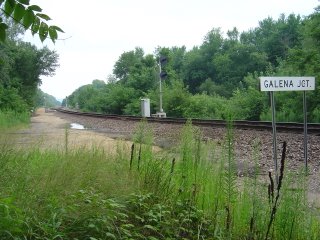 After I see the man flip the sign over to read "closed," I wrap things up and head out. The rain has stopped, so I pull my bike out of the Element and ride along a short rail-trail through the woods; it's pretty and stretches my legs out before it comes to an abrupt halt where the railroad still runs.
After I see the man flip the sign over to read "closed," I wrap things up and head out. The rain has stopped, so I pull my bike out of the Element and ride along a short rail-trail through the woods; it's pretty and stretches my legs out before it comes to an abrupt halt where the railroad still runs.I drive across the river to the center of town. It is, as advertised, extraordinarily well preserved, at least in the sense of having old brick buildings and a cobblestone-paved side streets and big, grand Victorian houses high on the hill. But in other ways, it's the phoniest place I've been on the trip, and it doesn't feel historical in the least. Like South Haven, Galena has a downtown where there's nothing on the main street except stores and restaurants for tourists. It's like a whole, giant mall of Things You Don't Need.
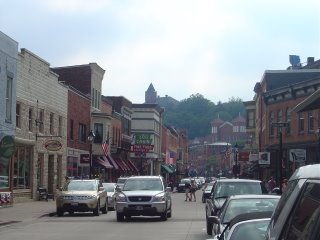 South Haven, at least, has the excuse that it's been a tourist town from the beginning, and that there's a beach that's the reason people go there. Galena feels like a town that attracts tourists because it's a tourist town.
South Haven, at least, has the excuse that it's been a tourist town from the beginning, and that there's a beach that's the reason people go there. Galena feels like a town that attracts tourists because it's a tourist town.I beat it off the main drag, up one of the cobblestone streets. (That, at least, feels historical; it's difficult and painful to walk up in my good shoes, and makes me realize how unpleasant it must have been to be a draft horse 100 years ago.) I find the historical museum, where the man leaving tells me they closed 20 minutes earlier. I see a bunch of young Mexicans hanging out behind one of the restaurants in town, which is a more authentic kind of history being played out today than anything the bored tourists are looking at a block away.
 There's a little church that I walk up to just to get a picture. It turns out to be the town's Episcopal Church. A sign at the door indicates that it was consecrated by Bishop Philander Chase, who founded and ran Kenyon College before the faculty booted him out and he headed west to Illinois to try again at Jubilee College. The church is empty but the door to a side chapel is unlocked, and from there I sneak in to admire the sanctuary. It's tiny and straightforward and feels basically earnest. As much as any denomination that I'm familiar with, I've come to admire the Episcopalians for making an honest effort to figure things out in an uncertain world.
There's a little church that I walk up to just to get a picture. It turns out to be the town's Episcopal Church. A sign at the door indicates that it was consecrated by Bishop Philander Chase, who founded and ran Kenyon College before the faculty booted him out and he headed west to Illinois to try again at Jubilee College. The church is empty but the door to a side chapel is unlocked, and from there I sneak in to admire the sanctuary. It's tiny and straightforward and feels basically earnest. As much as any denomination that I'm familiar with, I've come to admire the Episcopalians for making an honest effort to figure things out in an uncertain world.I feel like I'm trespassing, but I tell myself that intent matters in these situations. After I leave I walk across the street to tell them that they've left the door unlocked, and some latter-day Jean Valjean might come in and make off with the silver, but there's nobody around.
Quad Cities Swing
Unsurprisingly, a wooded campsite located alongslide a slowly moving river abounds in bugs. Suffice it to say that I resolve to me more careful about the tent zipper in the future.
 There's a bike trail that runs from Savanna to the Quad Cities, a distance of about 50 miles. I follow the first part of it, as well as a loop around a section of backwaters where I see huge numbers, and huge examples, of heron and other wading birds. Unfortunately, none of them cooperate with my desire to take their picture. One or two snakes behave no better, but that's just as well.
There's a bike trail that runs from Savanna to the Quad Cities, a distance of about 50 miles. I follow the first part of it, as well as a loop around a section of backwaters where I see huge numbers, and huge examples, of heron and other wading birds. Unfortunately, none of them cooperate with my desire to take their picture. One or two snakes behave no better, but that's just as well.
I take the trail as far as it's a separate path from the roadway. Then the map tells me to follow the highway a bit to Thomson. Not so much fun. After five minutes of being buzzed by pickup trucks and other assorted hilligans I give up the quest. When I get back to the tourist center at the trailhead, the same woman who was so encouraging two hours ago nods her head like she knew it would be hellish all along. The Burlington Northern tracks would make a lovely rail-trail, but given the number of trains that woke me up last night, that seems unlikely in the near future.
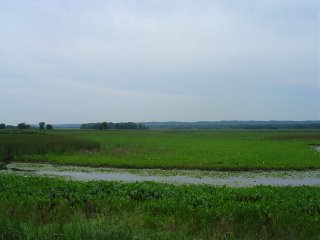 This is what the backwaters look like. All that plant life, the cattails on the left particularly, are a bad sign, by the way. They indicate an overabundance of nitrogen in the water, which feeds the cattails, which in turn block sunlight from the aquatic plants underneath that generate the river's oxygen supply. You see where this is headed.
This is what the backwaters look like. All that plant life, the cattails on the left particularly, are a bad sign, by the way. They indicate an overabundance of nitrogen in the water, which feeds the cattails, which in turn block sunlight from the aquatic plants underneath that generate the river's oxygen supply. You see where this is headed.
The nitrogen oversupply is the result of bad farming practices, especially the corn monoculture and the tendency of farmers to think too much fertilizer is better than too little. I could go on, but I know what's coming, so I'll probably get to the rest of it in a couple of days.
 In the afternoon I drive down the Iowa side of the river toward the Quad (Quint?) Cities. It's slow going, for some reason - there's less to see than I might have imagined. One thing there is a lot of is gambling. Every little dot on the map has a riverboat casino. I'm only to Iowa and I'm astonished at the amount of gambling there is in this country. If you had asked me, I would have told you Atlantic City, Vegas, and some Indian reservations. In fact, I have hardly been anyplace where the populace is more than an hour or two's drive from the opportunity to lose their money.
In the afternoon I drive down the Iowa side of the river toward the Quad (Quint?) Cities. It's slow going, for some reason - there's less to see than I might have imagined. One thing there is a lot of is gambling. Every little dot on the map has a riverboat casino. I'm only to Iowa and I'm astonished at the amount of gambling there is in this country. If you had asked me, I would have told you Atlantic City, Vegas, and some Indian reservations. In fact, I have hardly been anyplace where the populace is more than an hour or two's drive from the opportunity to lose their money.
It's not that I have a moral objection to it, really; I've played blackjack at Vegas and Tunica myself and bought the occasional lottery ticket. It's just that it seems a fundamentally stupid and dishonest - and, I may add, in the long run counterproductive - way to build an economy and fund government.
Which, all in all, probably does amount to a moral objection.
Whatever. I pass a place with a chicken in a top hat on the roof, and it tempts me far more than any casino does, even though it's not anything like a meal time. But it's going to take 20 minutes for me to get my hands on "broasted" chicken, so I keep moving. I get to the Buffalo Bill museum a few minutes after closing - damn you, top-hatted chicken! - so I am unable to tell you anything about his boyhood life near LeClaire, Iowa. Finally I arrive at Bettendorf, drive past the immense Alcoa plant by the river, and pull into Davenport.
Part of the reason I came to this part of the world is that my grandmother was from here, and I still have some more distant relations around these parts, good Swedish stock from little towns that are on the verge of disappearing. So on the verge of disappearing, it seems, that Rand McNally doesn't even bother showing them, and it shows some pretty dinky towns. Or maybe I have the names wrong. I don't really know what I would do when I got there besides take a picture of the church and walk through the graveyard, so I'm not bothered that much by it. Except that, otherwise, the Quad Cities are a pretty unlikely destination.
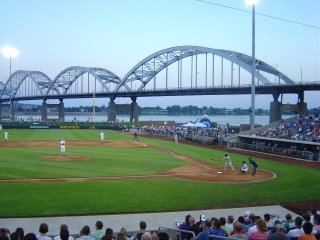 Except again, on the third, hand, there's a beautiful little ballpark in Davenport that overlooks the Mississippi as it flows westward. (Yes, westward; check your map of these parts.) The Quad Cities Swing - formerly the River Bandits, and why anyone thought "Swing" was a better name is beyond me; this is not exactly a hotbed of jazz or anything besides Sousa marches, from what I can tell - and they kept what I assume is the old mascot, a racoon with, naturally, a mask. The marketing folks were doubtless completely unequal to the task of devising a mascot to go along with "Swing," since I can't imagine the focus groups of eight-year-olds reacted positively to a six-foot walking saxophone ... where the hell was I?
Except again, on the third, hand, there's a beautiful little ballpark in Davenport that overlooks the Mississippi as it flows westward. (Yes, westward; check your map of these parts.) The Quad Cities Swing - formerly the River Bandits, and why anyone thought "Swing" was a better name is beyond me; this is not exactly a hotbed of jazz or anything besides Sousa marches, from what I can tell - and they kept what I assume is the old mascot, a racoon with, naturally, a mask. The marketing folks were doubtless completely unequal to the task of devising a mascot to go along with "Swing," since I can't imagine the focus groups of eight-year-olds reacted positively to a six-foot walking saxophone ... where the hell was I?
The ballpark. I'd seen pictures of it a long time ago, and it was in the news a few years ago when the whole Mississippi valley was flooding and the stadium was underwater. It sits right on the banks of the river, next to one of the bridges. This is low-level minor league ball; most of the players are barely out of high school, and sometimes they play like it. I've never heard of any of them, of course, but one of the players for Clinton, just up the road, is named John Mayberry and turns out to be the son of the former major leaguer.
It's a beautiful evening at the ballpark. And one of the things that's nice is that the fans are actually interested in the outcome of the game, and pay attention, and know their baseball, even if it will be a whole different cast of characters here next spring.
 There's also a sprinkler delay around the fifth or sixth inning. And a rabbit delay in about the eighth. And they give away free loaves of bread after the game.
There's also a sprinkler delay around the fifth or sixth inning. And a rabbit delay in about the eighth. And they give away free loaves of bread after the game.
Davenport turns out to be a pretty cool little town. I recall that during the Mississippi floods, Bob Edwards asked the mayor of Davenport, which was hit especially hard, why the town hadn't built levees the way most of the towns upstream had. The mayor's response was that being connected to the river was especially important to the psyche of the people of Davenport. Walking along the riverfront park before the game, I can see what he means. There's a nice bike path and a bandshell and restaurants, as well as the inevitable casino, of course, and a lot of people out using them. And being able to see the water, as opposed to a grassy berm, makes all the difference.
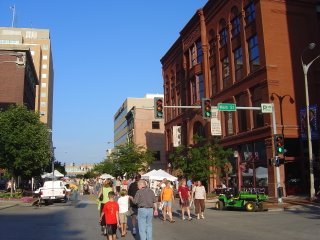 There's also an arts festival going on downtown, a couple of blocks from the stadium, and before the game I wander through. It's a relatively small affair, but it's pretty good and far less commercial than you might see at a street fair some other places.
There's also an arts festival going on downtown, a couple of blocks from the stadium, and before the game I wander through. It's a relatively small affair, but it's pretty good and far less commercial than you might see at a street fair some other places.
 They've also got a big new art museum, the Figge, that's celebrating it's first anniversary with free admission. It's a terrific little collection. Totally weird and eclectic, but terrific. There's far more Haitian art than you'd expect to find anywhere in Iowa, for example. And there's a Grant Wood room, which turns out not to have very much by Grant Wood in it, and certainly none of the greatest hits, but has some spectacular little works by a guy named Marvin Cone. One of them, a landscape of a river valley where the whole world seems to be swirling, reminds me of what it was like to see the Burghers of Calais for the first time or Basquiat's Boy and Dog in a Johnnypump: I never want to stop looking at it.
They've also got a big new art museum, the Figge, that's celebrating it's first anniversary with free admission. It's a terrific little collection. Totally weird and eclectic, but terrific. There's far more Haitian art than you'd expect to find anywhere in Iowa, for example. And there's a Grant Wood room, which turns out not to have very much by Grant Wood in it, and certainly none of the greatest hits, but has some spectacular little works by a guy named Marvin Cone. One of them, a landscape of a river valley where the whole world seems to be swirling, reminds me of what it was like to see the Burghers of Calais for the first time or Basquiat's Boy and Dog in a Johnnypump: I never want to stop looking at it.
The museum reminds me of the Columbus Museum of Art back when their collection was weaker and they had to work a little harder, and in the end it was a place where art was a whole lot more interesting.
So finally the game ends, and there's a fireworks show, and I can't find any karaoke, and I cross the river and head back up toward the campground. I pass the John Deere headquarters on the way, which I later learn was designed by Eero Saarinen and probably worth seeing in the daytime, but that'll have to wait.
 There's a bike trail that runs from Savanna to the Quad Cities, a distance of about 50 miles. I follow the first part of it, as well as a loop around a section of backwaters where I see huge numbers, and huge examples, of heron and other wading birds. Unfortunately, none of them cooperate with my desire to take their picture. One or two snakes behave no better, but that's just as well.
There's a bike trail that runs from Savanna to the Quad Cities, a distance of about 50 miles. I follow the first part of it, as well as a loop around a section of backwaters where I see huge numbers, and huge examples, of heron and other wading birds. Unfortunately, none of them cooperate with my desire to take their picture. One or two snakes behave no better, but that's just as well.I take the trail as far as it's a separate path from the roadway. Then the map tells me to follow the highway a bit to Thomson. Not so much fun. After five minutes of being buzzed by pickup trucks and other assorted hilligans I give up the quest. When I get back to the tourist center at the trailhead, the same woman who was so encouraging two hours ago nods her head like she knew it would be hellish all along. The Burlington Northern tracks would make a lovely rail-trail, but given the number of trains that woke me up last night, that seems unlikely in the near future.
 This is what the backwaters look like. All that plant life, the cattails on the left particularly, are a bad sign, by the way. They indicate an overabundance of nitrogen in the water, which feeds the cattails, which in turn block sunlight from the aquatic plants underneath that generate the river's oxygen supply. You see where this is headed.
This is what the backwaters look like. All that plant life, the cattails on the left particularly, are a bad sign, by the way. They indicate an overabundance of nitrogen in the water, which feeds the cattails, which in turn block sunlight from the aquatic plants underneath that generate the river's oxygen supply. You see where this is headed.The nitrogen oversupply is the result of bad farming practices, especially the corn monoculture and the tendency of farmers to think too much fertilizer is better than too little. I could go on, but I know what's coming, so I'll probably get to the rest of it in a couple of days.
 In the afternoon I drive down the Iowa side of the river toward the Quad (Quint?) Cities. It's slow going, for some reason - there's less to see than I might have imagined. One thing there is a lot of is gambling. Every little dot on the map has a riverboat casino. I'm only to Iowa and I'm astonished at the amount of gambling there is in this country. If you had asked me, I would have told you Atlantic City, Vegas, and some Indian reservations. In fact, I have hardly been anyplace where the populace is more than an hour or two's drive from the opportunity to lose their money.
In the afternoon I drive down the Iowa side of the river toward the Quad (Quint?) Cities. It's slow going, for some reason - there's less to see than I might have imagined. One thing there is a lot of is gambling. Every little dot on the map has a riverboat casino. I'm only to Iowa and I'm astonished at the amount of gambling there is in this country. If you had asked me, I would have told you Atlantic City, Vegas, and some Indian reservations. In fact, I have hardly been anyplace where the populace is more than an hour or two's drive from the opportunity to lose their money.It's not that I have a moral objection to it, really; I've played blackjack at Vegas and Tunica myself and bought the occasional lottery ticket. It's just that it seems a fundamentally stupid and dishonest - and, I may add, in the long run counterproductive - way to build an economy and fund government.
Which, all in all, probably does amount to a moral objection.
Whatever. I pass a place with a chicken in a top hat on the roof, and it tempts me far more than any casino does, even though it's not anything like a meal time. But it's going to take 20 minutes for me to get my hands on "broasted" chicken, so I keep moving. I get to the Buffalo Bill museum a few minutes after closing - damn you, top-hatted chicken! - so I am unable to tell you anything about his boyhood life near LeClaire, Iowa. Finally I arrive at Bettendorf, drive past the immense Alcoa plant by the river, and pull into Davenport.
Part of the reason I came to this part of the world is that my grandmother was from here, and I still have some more distant relations around these parts, good Swedish stock from little towns that are on the verge of disappearing. So on the verge of disappearing, it seems, that Rand McNally doesn't even bother showing them, and it shows some pretty dinky towns. Or maybe I have the names wrong. I don't really know what I would do when I got there besides take a picture of the church and walk through the graveyard, so I'm not bothered that much by it. Except that, otherwise, the Quad Cities are a pretty unlikely destination.
 Except again, on the third, hand, there's a beautiful little ballpark in Davenport that overlooks the Mississippi as it flows westward. (Yes, westward; check your map of these parts.) The Quad Cities Swing - formerly the River Bandits, and why anyone thought "Swing" was a better name is beyond me; this is not exactly a hotbed of jazz or anything besides Sousa marches, from what I can tell - and they kept what I assume is the old mascot, a racoon with, naturally, a mask. The marketing folks were doubtless completely unequal to the task of devising a mascot to go along with "Swing," since I can't imagine the focus groups of eight-year-olds reacted positively to a six-foot walking saxophone ... where the hell was I?
Except again, on the third, hand, there's a beautiful little ballpark in Davenport that overlooks the Mississippi as it flows westward. (Yes, westward; check your map of these parts.) The Quad Cities Swing - formerly the River Bandits, and why anyone thought "Swing" was a better name is beyond me; this is not exactly a hotbed of jazz or anything besides Sousa marches, from what I can tell - and they kept what I assume is the old mascot, a racoon with, naturally, a mask. The marketing folks were doubtless completely unequal to the task of devising a mascot to go along with "Swing," since I can't imagine the focus groups of eight-year-olds reacted positively to a six-foot walking saxophone ... where the hell was I?The ballpark. I'd seen pictures of it a long time ago, and it was in the news a few years ago when the whole Mississippi valley was flooding and the stadium was underwater. It sits right on the banks of the river, next to one of the bridges. This is low-level minor league ball; most of the players are barely out of high school, and sometimes they play like it. I've never heard of any of them, of course, but one of the players for Clinton, just up the road, is named John Mayberry and turns out to be the son of the former major leaguer.
It's a beautiful evening at the ballpark. And one of the things that's nice is that the fans are actually interested in the outcome of the game, and pay attention, and know their baseball, even if it will be a whole different cast of characters here next spring.
 There's also a sprinkler delay around the fifth or sixth inning. And a rabbit delay in about the eighth. And they give away free loaves of bread after the game.
There's also a sprinkler delay around the fifth or sixth inning. And a rabbit delay in about the eighth. And they give away free loaves of bread after the game.Davenport turns out to be a pretty cool little town. I recall that during the Mississippi floods, Bob Edwards asked the mayor of Davenport, which was hit especially hard, why the town hadn't built levees the way most of the towns upstream had. The mayor's response was that being connected to the river was especially important to the psyche of the people of Davenport. Walking along the riverfront park before the game, I can see what he means. There's a nice bike path and a bandshell and restaurants, as well as the inevitable casino, of course, and a lot of people out using them. And being able to see the water, as opposed to a grassy berm, makes all the difference.
 There's also an arts festival going on downtown, a couple of blocks from the stadium, and before the game I wander through. It's a relatively small affair, but it's pretty good and far less commercial than you might see at a street fair some other places.
There's also an arts festival going on downtown, a couple of blocks from the stadium, and before the game I wander through. It's a relatively small affair, but it's pretty good and far less commercial than you might see at a street fair some other places. They've also got a big new art museum, the Figge, that's celebrating it's first anniversary with free admission. It's a terrific little collection. Totally weird and eclectic, but terrific. There's far more Haitian art than you'd expect to find anywhere in Iowa, for example. And there's a Grant Wood room, which turns out not to have very much by Grant Wood in it, and certainly none of the greatest hits, but has some spectacular little works by a guy named Marvin Cone. One of them, a landscape of a river valley where the whole world seems to be swirling, reminds me of what it was like to see the Burghers of Calais for the first time or Basquiat's Boy and Dog in a Johnnypump: I never want to stop looking at it.
They've also got a big new art museum, the Figge, that's celebrating it's first anniversary with free admission. It's a terrific little collection. Totally weird and eclectic, but terrific. There's far more Haitian art than you'd expect to find anywhere in Iowa, for example. And there's a Grant Wood room, which turns out not to have very much by Grant Wood in it, and certainly none of the greatest hits, but has some spectacular little works by a guy named Marvin Cone. One of them, a landscape of a river valley where the whole world seems to be swirling, reminds me of what it was like to see the Burghers of Calais for the first time or Basquiat's Boy and Dog in a Johnnypump: I never want to stop looking at it.The museum reminds me of the Columbus Museum of Art back when their collection was weaker and they had to work a little harder, and in the end it was a place where art was a whole lot more interesting.
So finally the game ends, and there's a fireworks show, and I can't find any karaoke, and I cross the river and head back up toward the campground. I pass the John Deere headquarters on the way, which I later learn was designed by Eero Saarinen and probably worth seeing in the daytime, but that'll have to wait.
Wednesday, August 23, 2006
Big River
 I have in mind to go due west to the Mississippi River and then follow it north to Minneapolis. Another of my old Citigroup colleagues suggests camping at a place called the Mississippi Palisades, and I head in that direction.
I have in mind to go due west to the Mississippi River and then follow it north to Minneapolis. Another of my old Citigroup colleagues suggests camping at a place called the Mississippi Palisades, and I head in that direction.The road, Illinois Route 64, leads out North Avenue - which actually starts in Chicago, not far from Wrigley - through the western suburbs, past the Dekalb County courthouse in Sycamore, and brings me to Oregon, Illinois, on the banks of the Rock River. South of town there's a state park where I stop to take in the scenery and take a short hike in the woods, and to climb to the top of Castle Rock, which is a sort of local landmark. The view from the top is nice enough.
As for Castle Rock itself, however, the stairs I climb for the view intrude a little on its scenic value:

 While I'm there another visitor asks if I've seen the statue, and I remember that Joe had mentioned something about that. The man gives me directions to it, back north of Oregon, so I double back to see Chief Blackhawk's image recreated in the world's second-largest concrete statue. It turns out to be a generic Indian that everyone has since decided is Chief Blackhawk. It's pretty big. It's not the worst statue I've ever seen.
While I'm there another visitor asks if I've seen the statue, and I remember that Joe had mentioned something about that. The man gives me directions to it, back north of Oregon, so I double back to see Chief Blackhawk's image recreated in the world's second-largest concrete statue. It turns out to be a generic Indian that everyone has since decided is Chief Blackhawk. It's pretty big. It's not the worst statue I've ever seen.Back in Oregon I stop at a place that looks like a charming, '50s-era roadside stand, and that's exactly what it is: a place that looks like a charming, etc. It's not the worst burger I've ever eaten.
I head southwest, following the Rock River through Grand Detour, Dixon, and the twin towns of Sterling and Rock Falls. Grand Detour is where John Deere developed the steel plow, and there's a little working museum run by the John Deere Company to celebrate the man's life. I can take an informative and educational tour to see a recreation of the blacksmith shop, etc., which the woman at the desk makes to sound almost as much fun as a big bowl of wheat germ. I pass. I do stop to look at the prairie they've planted out front, presumably to commemorate the eradication of the prairie by the steel plow.
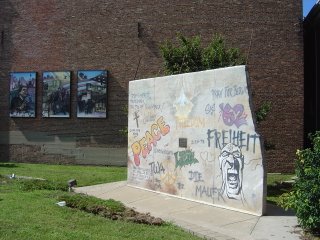 Dixon was the boyhood home of Ronald Reagan, which is not obvious from the main road through town and which I do not stop to look for. There is a hunk of the Berlin Wall, placed there in his honor, and I take a picture of it as a substitute.
Dixon was the boyhood home of Ronald Reagan, which is not obvious from the main road through town and which I do not stop to look for. There is a hunk of the Berlin Wall, placed there in his honor, and I take a picture of it as a substitute.There are no falls in Rock Falls, only a large and unpicturesque weir dam. Sterling has a mural depicting the eight presidents who have visited Sterling. I keep moving.
I'm headed toward the Quad Cities of Moline, Rock Island, Davenport, and (there is some debate on this point, apparently) either Bettendorf or East Moline. Butwhen I hit US 30 I decide to cut due west, the better to get my tent up at a reasonable hour. It's a mostly uninspiring ride across cornfields. The map makes it look like I will drive smack into the river, but that's not quite the way the topography works around here. Instead, when I get to route 84, designated as part of the Great River Road, I see an earthen berm ahead of me and not much else. It's that way for a while as I follow the road north toward Savanna.
 And suddenly there it is. I'm surprised when I see it. Reggie and I were in Memphis a few years ago, and the river there was violently roiling, full of mud and branches and commerce, a force to be reckoned with. It was the Mississippi River that I recognized from Huck Finn and all the rest of American mythology. Here, where it's been carefully dammed and there's quite a bit less water flowing through it anyway - we're above the confluences of the Ohio and the Missouri, after all - it's flat and placid, still a mile or more wide but nothing that seems capable of defining a civilization. Still, it's the great border between East and West, and when I pass the sign that names it - without fuss, as if it were the Shenango or something - I feel a little pull.
And suddenly there it is. I'm surprised when I see it. Reggie and I were in Memphis a few years ago, and the river there was violently roiling, full of mud and branches and commerce, a force to be reckoned with. It was the Mississippi River that I recognized from Huck Finn and all the rest of American mythology. Here, where it's been carefully dammed and there's quite a bit less water flowing through it anyway - we're above the confluences of the Ohio and the Missouri, after all - it's flat and placid, still a mile or more wide but nothing that seems capable of defining a civilization. Still, it's the great border between East and West, and when I pass the sign that names it - without fuss, as if it were the Shenango or something - I feel a little pull.
Brent, my Citigroup colleague, was right: the Mississippi Palisades is a lovely spot. I choose a campsite in a remote corner of the campground, and then go to set up and realize that, however appealing this site may be, it does not anywhere have a six-by-six area of level ground to pitch a tent on.
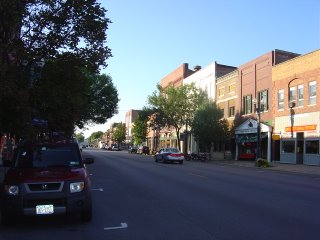 I stop in Savanna to pick up some supplies and look around. It's Friday night, and the street is mostly populated with teenagers waiting for the movie theater to open and looking like they wish they were growing up somewhere else. I can't really fault them for that: it's a pretty enough spot, and if you like biking or fishing - or the signs indicate, squirrel hunting - there's that to do. But otherwise Savanna's a little short on thrills. (Well: it's also a motorcycle haven, which makes sense given the highway that cuts through it, and that may bring occasional excitement.) It doesn't even have an internet cafe, or a coffee bar of any stripe.
I stop in Savanna to pick up some supplies and look around. It's Friday night, and the street is mostly populated with teenagers waiting for the movie theater to open and looking like they wish they were growing up somewhere else. I can't really fault them for that: it's a pretty enough spot, and if you like biking or fishing - or the signs indicate, squirrel hunting - there's that to do. But otherwise Savanna's a little short on thrills. (Well: it's also a motorcycle haven, which makes sense given the highway that cuts through it, and that may bring occasional excitement.) It doesn't even have an internet cafe, or a coffee bar of any stripe.No matter (other than, I suppose, yet further delays in my ability to deliver these missives to you, fair reader. Still, the world waited two years for Lewis and Clark's report. You can hang on a couple weeks.)
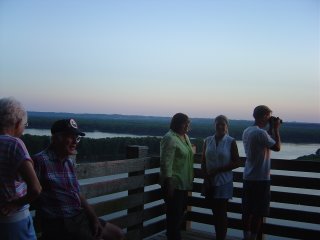 I head back toward the state park and realize it's going to be sunset soon, and, the way I'm planning things, my only sunset here. So I drive to the top of the bluff and take the short walk down to the end of the Sunset Trail. I'd been imagining solitude, but of course I don't get that. Instead, there are a few groups of like-minded travelers. Two generations of Californians driving an RV from Victorville to Columbus to see their granddaughter and great-granddaughter for the first time. A couple from Iowa whose itinerary I never quite figure out. A woman who left her father and his bad knees in the car until the great-grandfather insists he can't miss this. We share stories of the road, tell each other the sites not to miss, take pictures of each other in front of the view. (I do not improve upon the natural spectacle in mine, and you will not see it.) And it's just beautiful, and then the sun sets, and it's still beautiful.
I head back toward the state park and realize it's going to be sunset soon, and, the way I'm planning things, my only sunset here. So I drive to the top of the bluff and take the short walk down to the end of the Sunset Trail. I'd been imagining solitude, but of course I don't get that. Instead, there are a few groups of like-minded travelers. Two generations of Californians driving an RV from Victorville to Columbus to see their granddaughter and great-granddaughter for the first time. A couple from Iowa whose itinerary I never quite figure out. A woman who left her father and his bad knees in the car until the great-grandfather insists he can't miss this. We share stories of the road, tell each other the sites not to miss, take pictures of each other in front of the view. (I do not improve upon the natural spectacle in mine, and you will not see it.) And it's just beautiful, and then the sun sets, and it's still beautiful.

I drive up and down the road a bit; the sky in the west slowly burns out, and the moon rises low to the south. For the fourth or fifth time, I feel like the trip is really beginning.
Monday, August 14, 2006
Havre and the Sweet Grass Hills
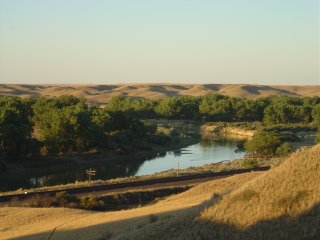 West of Bear Paw is Havre, at 9,500 people the biggest town on the High Line, covering about 570 miles of US 2. The road and I have been more or less following the Milk River for a while, alongside the Great Northern Railroad, which connected and created all these little dots a hundred years ago. I get to Havre as the afternoon is turning to evening, and I ought to be able to find someplace decent to eat, but I'm tired and hungry, and being tired and hungry I neither make good decisions nor feel the energy to explore too strenuously.
West of Bear Paw is Havre, at 9,500 people the biggest town on the High Line, covering about 570 miles of US 2. The road and I have been more or less following the Milk River for a while, alongside the Great Northern Railroad, which connected and created all these little dots a hundred years ago. I get to Havre as the afternoon is turning to evening, and I ought to be able to find someplace decent to eat, but I'm tired and hungry, and being tired and hungry I neither make good decisions nor feel the energy to explore too strenuously.So I land at a place called 4 B's, which turns out to be a chain with eight or ten locations in Montana and is basically a Denny's with a sepiatone interior and a casino attached. The food is pretty terrible. I ought to be eating a big old angus steak with men wearing cowboy hats, but instead I'm eating recently-thawed trout and hash-browns.
I have been learning this about myself: I get cranky and make bad decisions when I'm hungry. The former I probably knew before this trip; the latter has been impressed upon me more than I would choose.
 There's something called "Havre Beneath the Streets" in Havre, but the hour being afternoon turning to evening, I've missed it. There's not much hopping in Havre but the casinos, of which there are plenty. It is, by all appearances, another town that works hard and drinks hard. Or maybe it drinks hard because times are hard.
There's something called "Havre Beneath the Streets" in Havre, but the hour being afternoon turning to evening, I've missed it. There's not much hopping in Havre but the casinos, of which there are plenty. It is, by all appearances, another town that works hard and drinks hard. Or maybe it drinks hard because times are hard.There are a bunch of tacky-looking motels, but I'm still trying to get to see my cousins in Browning and/or Missoula before the next millennium. I do stop at a payphone to call Reggie, since my phone still waits somewhere ahead of me. As if having it would make a difference, given Nextel's "coverage" in this part of the world.
There's also a sign directing you to another country nearby:

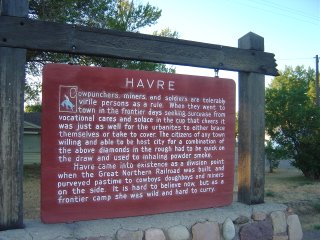 The most entertaining thing in Havre turns out to be the historical interest sign. One doesn't ordinarily expect to find phrases like "tolerably virile persons" and "seeking surcease from vocational cares and solace in the cup that cheers." Maybe somebody was bored, or maybe somebody's supervisor felt some obfuscation was preferable to "They drank and whored 'til a fight broke out, and then they shot each other." In any case, it may be hackneyed writing and bad history, but at least someone responsible for putting up the roadside markers in Montana has a pulse.
The most entertaining thing in Havre turns out to be the historical interest sign. One doesn't ordinarily expect to find phrases like "tolerably virile persons" and "seeking surcease from vocational cares and solace in the cup that cheers." Maybe somebody was bored, or maybe somebody's supervisor felt some obfuscation was preferable to "They drank and whored 'til a fight broke out, and then they shot each other." In any case, it may be hackneyed writing and bad history, but at least someone responsible for putting up the roadside markers in Montana has a pulse.I drive on until dark and past dark, which I hate to do because even the flat plains of central Montana are worth looking at. Another sign informs me that I'm not seeing the Sweet Grass Hills, which US 2 bends to the south of and which, if you can trust the sign-writer, are of great cultural significance to the Blackfeet, as well as an important spot for hunting game.
The longer I drive this road the longer it seems it will be until I return. So I decide to pull in at some small town and find a place to sleep. There aren't too many chain motels around here, and the mom and pop places tend to turn out the lights at 10 or 11 pm, so I pull into the city park. You can camp in the city park in this part of the country, and a couple of motorcyclists are doing just that. For my part, I put the seats back and stretch out, staring through the moon roof at the big sky full of stars .
In the morning I say hello to one of the motorcyclists. It's the Sturgis time of year, but they've chosen to avoid that mess, he tells me. I realize that I'm glad my route isn't taking me through South Dakota, after all. They strike their tent; I rearrange the gear and head west without breakfast.
This is what the Sweet Grass Hills look like in the daylight:
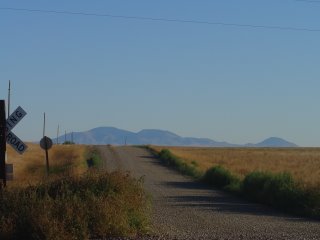
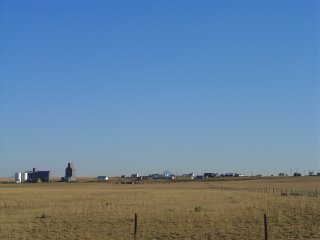 It's still flat here, the winds are still blowing down the streets of tiny towns, and the trains of the BNSF still pass me, full of coal or going back for another load, every ten minutes or so. If I wanted to be a millionaire - and there's nothing about the way I've led my life so far that suggests I do - I'd figure out how to build wind farms all over the place and ship cheap and green electricity back to Chicago.
It's still flat here, the winds are still blowing down the streets of tiny towns, and the trains of the BNSF still pass me, full of coal or going back for another load, every ten minutes or so. If I wanted to be a millionaire - and there's nothing about the way I've led my life so far that suggests I do - I'd figure out how to build wind farms all over the place and ship cheap and green electricity back to Chicago.